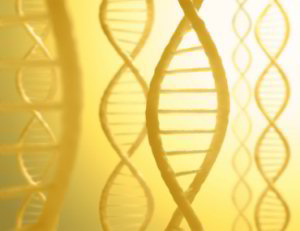All metabolic pathways of life on earth contain DNA and RNA with double helix spirals in one direction, counterclockwise in right-handed twists. When facing the molecule head on, it looks like an ordinary screw with its spirals twisting in one direction, that is, to the right. The rule for screws is “To the right to tighten, and to the left to loosen.” This is also the case with living matter, and the products of living mater, like sugar from sugar cane, or milk from cows. Sugar water polarizes light to the right only. Now, how do the molecules know which is right and left? And what’s this got to do with dentistry?
Well, not even bacteria can survive on left-handed food sources. Their enzymes for digestion are symmetric, right-handed. They are not asymmetric, left-handed with a clockwise twist. Enzymes in living matter are suited to digest only right-handed spiraled sugars. That is, right-twist pathways tighten the bacteria’s link to life, and the left-twist pathways loosen that link.
 Since almost every metabolic pathway demands enzymatic bonding with specific ionic minerals to digest food or to function as muscles or nerve cells, the link to left- and right-handedness seems essential, esp. to long-range management against infection. Even on the level of the environment and genetic predisposition, of homeostasis and body cells, the fact is, the body cannot produce essential minerals like calcium, zinc or magnesium. The ionic forms of these minerals must come from outside the body. In order to regulate voluntarily and involuntarily muscles in both contraction and relaxation, enzyme complexes must use these minerals by drawing them into the muscle for contraction, and get rid of them for relaxation, within milliseconds. It’s an amazing feat in the preservation of life, let alone to ward off disease.
Since almost every metabolic pathway demands enzymatic bonding with specific ionic minerals to digest food or to function as muscles or nerve cells, the link to left- and right-handedness seems essential, esp. to long-range management against infection. Even on the level of the environment and genetic predisposition, of homeostasis and body cells, the fact is, the body cannot produce essential minerals like calcium, zinc or magnesium. The ionic forms of these minerals must come from outside the body. In order to regulate voluntarily and involuntarily muscles in both contraction and relaxation, enzyme complexes must use these minerals by drawing them into the muscle for contraction, and get rid of them for relaxation, within milliseconds. It’s an amazing feat in the preservation of life, let alone to ward off disease.
Infected tissues can become flooded with left-handed spiraled molecules to form a mixture with right-handed spiraled nutrition sources. The slightest “wrong-handed” amino acids along the molecular chains will disrupt proteins enough to reduce the formation of longer chains. In an aqueous environment with a low pH these wrong-handed blocks will loosen links more rapidly and disable enough information to support the life of the bacteria. Therefore, restoration of the living tissues utilizing is not so much “anti-bacterial” as cellular confirmation of the unique commonality of life. Right-handed pathways are for life. Left-handed pathways reduce replications that result in less reproductive activity.
When considering their rapid and efficient healing influences, a deep understanding of right-handedness in all forms of life has been an eye-opener related to Calcium Therapies. Although Calcium Therapies are quite tissue friendly and safe for environmental management and pH elevations, there is a “wrong-handedness” that persists in dentistry between the word “calcium” and the compound “calcium hydroxide.” While looking up information on the calcium ion and its relation to bacteria, I found voluminous articles on what seemed to be the last word on the subject. These papers covered the entire history of calcium hydroxide of literature based on references longer than the articles themselves. That begets the problem. In virtually every citation or abstract the words calcium, calcium ion, calcium hydroxide and calcium “anything” is referenced as if it were “calcium hydroxide.” I then realized once again that I had learned nothing about calcium hydroxide that I did not know in 1997, and on top of that, nothing about how the calcium ion reacts with bacteria, even in the bacterial articles.
This in how deeply imbedded the idea is in our psyches: “All calcium materials are calcium hydroxide.” This is “wrong-handed” from the facts. Each compound containing calcium has different properties and only one material is calcium hydroxide, which The Calcium Therapy Institute has rarely used for 45 years. Furthermore, dentistry can’t seem to get beyond the wrong-handed twist, and seems uninterested in doing so. The multitude of papers is a nice review of calcium hydroxide, however, not of ionic calcium. On the other hand, our blood serum research remains a classic breakthrough for the use of calcium materials. We did it in 1988 and it is published on the Site.
No calcium material is more safe, more effective and long-lasting as our 32- second calcium treatment of the oral cavity, and it is not about calcium hydroxide. Real Seal, Resilon, Dycal, etc…. are really not calcium hydroxide either, but they are excellent materials with calcium in them. And they may work quite well for root canals. We designed such a nonsurgical method and material in the 1960s with calcium, zinc and magnesium in them, and it was published in 1982, Oral Med. O. Path. O. Surg. Neither study utilizes calcium hydroxide. In fact, we have designed several calcium materials that are wonderful in every field of dentistry and can be used on every inch of the skin.
As this right-handedness is understood more clearly, there are other calcium methods and materials to be developed and enjoyed for the benefit dentistry, for medicine and the life of almost every patient.
